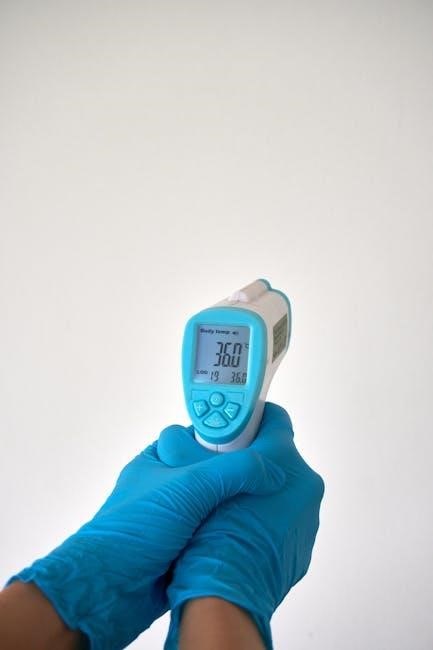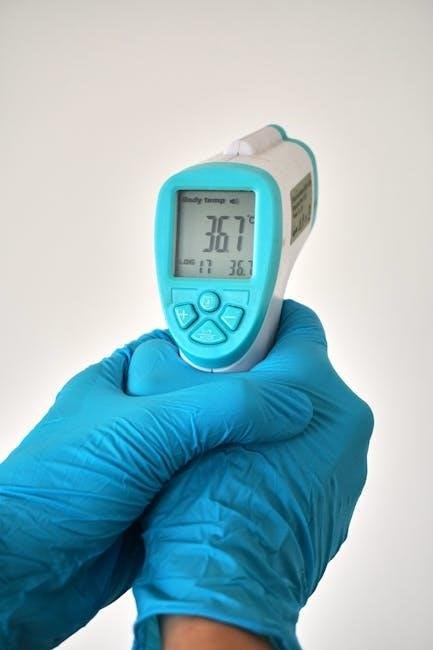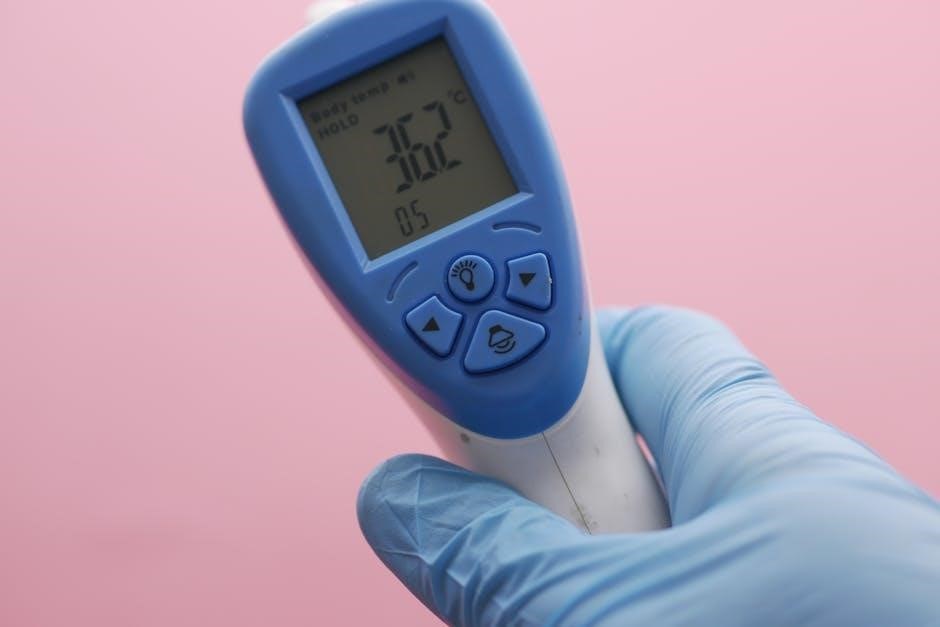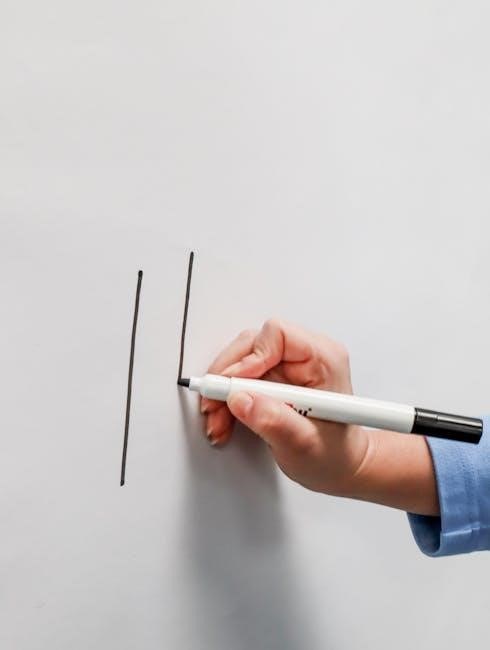
Welcome to the Infrared Thermometer Instruction Manual‚ your comprehensive guide to safe and effective use․ This PDF manual covers installation‚ setup‚ and operation for optimal performance․
1․1 What is an Infrared Thermometer?
An infrared thermometer is a non-contact device that measures the temperature of an object or surface by detecting the infrared radiation it emits․ It converts this radiation into a temperature reading‚ providing quick and accurate results without physical contact․ This technology is widely used in medical‚ industrial‚ and household settings due to its safety‚ convenience‚ and versatility․ The device is particularly useful for measuring forehead temperatures in healthcare settings‚ ensuring hygiene and reducing cross-contamination risks․
1․2 Importance of Reading the Instruction Manual
Reading the infrared thermometer instruction manual is crucial for safe and accurate operation․ It provides essential safety guidelines‚ operational steps‚ and troubleshooting tips‚ ensuring proper use․ The manual helps users understand device specifications‚ handling precautions‚ and maintenance requirements․ By following the instructions‚ users can avoid errors‚ extend the product’s lifespan‚ and ensure reliable measurements․ Compliance with safety standards and optimal performance are achieved when the manual is thoroughly reviewed before first use․

Components of the Infrared Thermometer
The infrared thermometer includes a handheld device‚ power supply‚ thermocouple‚ pouch‚ and user manual․ Key specs like measurement range and accuracy ensure precise temperature readings․
2․1 Physical Components of the Device
The infrared thermometer consists of a handheld unit with an LCD display‚ a built-in infrared sensor‚ and a laser for precise targeting․ It includes a 9V battery compartment‚ ensuring portability and ease of use․ The device also features a K-type thermocouple for enhanced accuracy in temperature measurement․ Additional components like a protective pouch are provided for safe storage․ The ergonomic design allows comfortable grip and operation‚ making it suitable for various applications‚ from medical use to industrial settings․ These physical components work together to deliver reliable and accurate temperature readings․
2․2 Accessories Included in the Package
The infrared thermometer package includes essential accessories to ensure optimal performance․ A 9V battery powers the device‚ while a K-type thermocouple enhances measurement accuracy․ A protective pouch is provided for safe storage and transport․ Additionally‚ the user manual‚ available as a downloadable PDF‚ offers detailed instructions for installation‚ setup‚ and troubleshooting․ These accessories collectively support the proper functioning and maintenance of the thermometer‚ ensuring accurate and reliable temperature readings across various applications․
2․3 Technical Specifications and Features
The infrared thermometer boasts a measurement range of -50°C to 1000°C‚ ensuring versatility across applications․ It features ±1% accuracy for precise readings and an adjustable emissivity setting for diverse surfaces․ The device includes a fast response time of 0․5 seconds and a clear LCD display․ Advanced models incorporate laser targeting for accurate aiming․ Additional features include data storage for up to 20 measurements and automatic shutdown to conserve battery life․ These specifications and features ensure reliable performance in both industrial and medical settings‚ as detailed in the user manual PDF․

Safety Instructions and Precautions
Read all safety instructions before first use․ Avoid direct exposure to the IR beam․ Keep away from children․ Do not use near flammable materials or in explosive environments․
3․1 General Safety Guidelines
Always read and follow the safety instructions provided in the manual․ Ensure the thermometer is used only for its intended purposes․ Avoid exposing the device to extreme temperatures or moisture․ Keep it out of reach of children․ Regularly inspect the device for damage and ensure all parts are securely attached․ Use the provided battery type to prevent malfunctions․ Store the thermometer in a dry‚ cool place when not in use․ Failure to comply may result in inaccurate readings or device damage․ Proper handling ensures safe and effective operation․
3․2 Handling and Storage Precautions
Handle the infrared thermometer with care to avoid damage․ Avoid exposure to extreme temperatures‚ moisture‚ or physical stress․ Clean the lens regularly with a soft cloth to maintain accuracy․ Store the device in a dry‚ cool place‚ away from direct sunlight․ Use the provided pouch for protection when not in use․ Remove batteries if storing for an extended period․ Ensure the thermometer is placed on a stable surface to prevent accidental drops․ Keep it out of reach of children․ Proper handling and storage ensure optimal performance and extend the device’s lifespan․
3․3 Usage Restrictions and Warnings
Use the infrared thermometer only for its intended purposes‚ such as forehead or surface temperature measurement․ Avoid using it in environments with high humidity or near flammable materials․ Do not submerge the device in water or expose it to direct sunlight for prolonged periods․ Keep the lens clean and free from obstructions․ Avoid touching the lens with bare hands․ Use the device only within the specified temperature range․ Do not use it on individuals with certain medical conditions without professional guidance․ Adhere to all safety guidelines provided in the manual to ensure accurate readings and safe operation․

Installation and Setup
Unpack the device‚ install the battery‚ and perform initial calibration as instructed․ Ensure all components are included and functioning properly before first use for accurate readings․
4․1 Preparing the Thermometer for Use
Start by unpacking the infrared thermometer and ensuring all components‚ such as the battery and thermocouple‚ are included․ Insert the provided 9V battery into the device‚ making sure it’s securely fitted to avoid any power issues․ Next‚ perform a quick check to ensure the LCD display lights up and shows no error messages․ Allow the device to acclimate to the surrounding temperature for about 10 minutes before use; This step is crucial for ensuring accurate measurements․ If the thermometer has a pouch‚ store it safely when not in use to protect the lens and maintain its precision․ Finally‚ review the manual to familiarize yourself with the device’s features and operation modes to ensure proper handling and functionality․
4․2 Initial Setup and Calibration
Power on the infrared thermometer and ensure the LCD display shows no error messages․ Perform a self-test by pressing and holding the measurement button for 3 seconds․ If the device requires calibration‚ refer to the manual for specific steps․ Some models may need a reference black body source for calibration․ Adjust the emissivity setting according to the object being measured‚ typically between 0․95 for human skin․ Once calibrated‚ the device is ready for use in forehead or surface measurement modes․ Always follow the manufacturer’s guidelines for calibration to ensure accurate readings․ Proper setup guarantees reliable performance and precise temperature measurements․

Operating the Infrared Thermometer
Aim the thermometer at the target‚ ensuring the lens is clean․ Press the measurement button‚ and wait for the beep․ Results appear on the LCD screen․
5․1 Basic Measurement Techniques
To ensure accurate readings‚ hold the thermometer steady and aim the lens directly at the target․ Maintain a distance as specified in the manual․ Clean the lens with a soft cloth to avoid interference․ For forehead measurements‚ position the device 1-3 inches away․ Press and hold the measurement button until you hear a beep․ The reading will display on the screen․ Avoid direct sunlight or external heat sources․ For surface measurements‚ ensure the area is dry․ Store the thermometer in a protective pouch when not in use to prevent damage․ Follow these steps for reliable results․
5․2 Using Different Modes (Forehead‚ Surface‚ etc․)
Switch between modes using the mode button․ For forehead mode‚ position the thermometer 1-3 inches away‚ ensuring the lens is clean and free from obstructions․ Press the scan button; a beep signals measurement completion․ For surface mode‚ aim at the target and press the scan button․ Avoid touching the lens to prevent interference․ Use the laser guide for precise targeting․ Ensure the surface is dry and free from contaminants for accurate readings․ Refer to the manual for specific mode settings and adjustments․ Always follow the manufacturer’s guidelines for optimal performance and accuracy in each mode․
5․3 Understanding the Display and Buttons
The display shows temperature readings‚ mode indicators‚ and battery status․ Use the mode button to switch between forehead and surface modes․ The scan button triggers measurements․ Press and hold for continuous scanning․ The laser button toggles the aiming laser on/off․ The backlight button illuminates the screen for visibility in low light; The display also shows unit (°C/°F) and memory recall icons․ Press the mode button to cycle through settings․ Ensure the lens is clean for accurate readings․ Familiarize yourself with these controls for efficient operation․ Refer to the manual for detailed button functions and display interpretations to ensure precise measurements every time․

Troubleshooting Common Issues
Identify issues like inaccurate readings or low battery․ Clean the lens‚ check settings‚ and ensure proper calibration․ Refer to the manual for error codes and solutions․
6․1 Common Errors and Solutions
Infrared thermometers may display inaccurate readings due to lens contamination or incorrect settings․ Clean the lens with a soft cloth and ensure proper calibration․ Low battery warnings can cause malfunctions; replace batteries promptly․ Environmental factors‚ such as high humidity or extreme temperatures‚ may affect accuracy․ Ensure the device is used within specified temperature ranges․ If the thermometer fails to turn on‚ check power buttons or battery connections․ For persistent issues‚ refer to the manual or contact customer support for further assistance․
6․2 Maintenance and Cleaning Tips
Regular maintenance ensures optimal performance of your infrared thermometer․ Clean the lens with a soft‚ dry cloth to avoid dust or smudges affecting accuracy․ Avoid using chemicals or abrasive materials‚ as they may damage the lens․ Store the device in a dry‚ cool place‚ away from direct sunlight․ Handle the thermometer with care to prevent physical damage․ For detailed cleaning instructions‚ refer to the manual․ Periodically check for firmware updates to ensure the device operates with the latest features and improvements․ Proper maintenance extends the lifespan and reliability of your infrared thermometer․

Selecting the Right Infrared Thermometer
Choose the right model based on your needs‚ considering technical specs‚ intended use‚ and safety guidelines․ Compare features and brands for the best fit․
7․1 Choosing Based on Intended Use
Selecting the right infrared thermometer starts with understanding its intended use․ For medical purposes‚ opt for models designed for forehead or body temperature measurement‚ ensuring accuracy and hygiene․ Industrial applications may require thermometers with higher temperature ranges and durability․ Consider features like non-contact functionality for safe measurements or laser sighting for precision․ Refer to the instruction manual for guidance on choosing the appropriate model for your specific needs‚ ensuring compliance with safety and regulatory standards for optimal performance and reliability across various scenarios․
7․2 Comparing Different Models and Brands
When comparing infrared thermometer models and brands‚ consider features like accuracy‚ temperature range‚ and intended use․ The IR-T1 model offers basic forehead and surface measurements‚ while the IR-T2 includes advanced features such as laser sighting and higher temperature capabilities․ Brands like CONDTROL are known for their reliability and compliance with FDA and CE standards; Evaluate the technical specifications‚ user reviews‚ and instruction manual details to determine the best fit for your needs․ This ensures you select a thermometer that meets both performance and safety requirements for medical or industrial applications․

Compliance with Regulations and Standards
This manual ensures your infrared thermometer meets FDA and CE standards‚ guaranteeing safety and accuracy for medical and industrial use‚ as specified in the instruction guide․
8․1 FDA and CE Compliance
Your infrared thermometer is designed to meet FDA and CE standards‚ ensuring safety and accuracy for medical and industrial applications․ Compliance with these regulations guarantees adherence to strict guidelines for performance and user safety․ The device undergoes rigorous testing to maintain these certifications‚ providing reliable temperature measurements․ Always verify the compliance markings on your thermometer to ensure it meets regulatory requirements for your intended use․ Proper calibration and maintenance‚ as outlined in this manual‚ are essential to uphold compliance and ensure accurate readings․ Adherence to these standards is crucial for both medical and industrial applications․
8․2 ISO Standards for Infrared Thermometers
Your infrared thermometer complies with ISO standards‚ ensuring high-quality performance and accuracy․ These standards define requirements for design‚ manufacturing‚ and testing to guarantee reliable temperature measurements․ ISO certification verifies the device’s ability to meet strict specifications for precision and durability․ Regular compliance checks ensure the thermometer operates within defined parameters‚ providing consistent and trustworthy results․ By adhering to ISO standards‚ the device delivers exceptional performance for both industrial and medical applications‚ maintaining user confidence and reliability․ Always refer to the manual for specific ISO compliance details and certification information․
8․3 Regulatory Requirements for Medical Use
For medical use‚ infrared thermometers must meet strict regulatory requirements․ Ensure compliance with FDA and CE standards for safety and accuracy․ The device must be registered with relevant authorities and bear appropriate certifications․ Regular calibration and maintenance are essential to maintain compliance․ Always follow guidelines for medical-grade thermometers‚ including proper hygiene practices and user training․ Refer to the manual for detailed compliance information and adherence to local regulations․ This ensures accurate and safe temperature measurement in healthcare settings‚ protecting both patients and users․ Compliance is non-negotiable for medical applications to uphold safety and reliability standards effectively․

Advantages of Using an Infrared Thermometer
Infrared thermometers offer non-contact measurement‚ ensuring safety and hygiene․ They provide quick and accurate readings‚ ideal for medical and industrial use․ Their efficiency and convenience make them indispensable․
9․1 Non-Contact Measurement Benefits
Infrared thermometers enable non-contact measurements‚ reducing the risk of cross-contamination and ensuring hygiene‚ especially in medical settings․ This feature is particularly useful for measuring temperatures in sensitive or hard-to-reach areas without physical contact․ Non-contact functionality also enhances safety when measuring high-temperature surfaces or objects‚ preventing potential burns or damage․ The ability to maintain a safe distance while obtaining accurate readings makes infrared thermometers highly efficient and practical for various applications‚ including forehead scanning for infants and adults․ This benefit is emphasized in the instruction manual‚ highlighting its importance for both convenience and safety․
9․2 Speed and Accuracy of Readings
Infrared thermometers provide rapid and precise temperature readings‚ typically within seconds‚ making them ideal for quick assessments․ Their accuracy is ensured through advanced sensor technology‚ delivering reliable results in various environments․ The devices are calibrated to minimize measurement errors‚ ensuring consistency across multiple uses․ For optimal accuracy‚ it’s crucial to follow the manual’s guidelines‚ such as maintaining the correct distance from the target and avoiding environmental interference․ This balance of speed and precision makes infrared thermometers indispensable for both medical and industrial applications‚ as highlighted in the instruction manual․
9․3 Hygiene and Safety in Medical Settings
In medical settings‚ infrared thermometers offer a non-contact method of measuring body temperature‚ reducing the risk of cross-contamination․ This feature is particularly beneficial for preventing the spread of infections and maintaining patient safety․ The devices are designed with hygiene in mind‚ allowing for quick‚ sanitary measurements without direct contact․ Proper cleaning and storage‚ as outlined in the manual‚ further ensure the thermometer’s reliability and safety․ These attributes make infrared thermometers a vital tool in healthcare environments‚ promoting both patient and staff well-being while adhering to hygiene standards․
Limitations of Infrared Thermometers
Infrared thermometers may face accuracy issues due to environmental factors like humidity or distance․ They also require proper calibration and can be more expensive than traditional methods․
10․1 Potential Sources of Inaccuracy
Infrared thermometers can experience accuracy issues due to environmental factors like ambient temperature‚ humidity‚ and dust․ Calibration errors or improper setup can also affect readings․ Physical obstructions‚ such as dirt on the lens‚ may block infrared signals․ Additionally‚ emissivity mismatches between the thermometer and the target surface can lead to incorrect measurements․ It is crucial to follow the manual’s guidelines for optimal performance and to ensure accurate results in various conditions․ Regular maintenance and proper handling are essential to minimize these potential sources of inaccuracy and ensure reliable temperature readings․
10․2 Environmental Factors Affecting Measurements
Environmental factors such as ambient temperature‚ humidity‚ and dust can impact the accuracy of infrared thermometer readings․ Extreme temperatures may cause sensor malfunctions‚ while high humidity can interfere with infrared signals․ Dust or debris on the lens can block or scatter infrared radiation‚ leading to inaccurate measurements․ Additionally‚ electromagnetic interference from nearby devices may affect performance․ It is essential to use the thermometer in environments within its specified operating range and ensure the lens is clean․ Proper storage and handling are also critical to maintaining measurement reliability in various conditions․
10․3 Cost and Maintenance Considerations
The cost of an infrared thermometer varies based on model and features‚ with basic units being more affordable than advanced medical-grade devices․ Maintenance involves regular battery replacements‚ lens cleaning‚ and occasional recalibration․ Proper care extends the device’s lifespan and ensures accuracy․ Users should budget for potential repairs or replacements if the thermometer is used frequently or in harsh environments․ While initial costs may seem high‚ proper upkeep can prevent costly errors and ensure long-term reliability‚ making it a worthwhile investment for precise temperature measurement needs․

Future Trends in Infrared Thermometer Technology
Future trends include enhanced sensor accuracy‚ real-time data syncing with smart devices‚ and expanded applications in industrial and environmental monitoring‚ revolutionizing temperature measurement across industries․
11․1 Advances in Sensor Technology
Advances in sensor technology are driving infrared thermometers to achieve higher accuracy and faster response times․ New sensors with enhanced thermal sensitivity and reduced size enable precise measurements in diverse environments․ These improvements allow for better performance in challenging conditions‚ such as extreme temperatures or varying distances․ Additionally‚ the integration of advanced algorithms improves data processing‚ ensuring more reliable readings․ As sensors evolve‚ they contribute to the overall reliability and versatility of infrared thermometers‚ making them indispensable tools across industries․ These innovations are expected to expand their applications in medical‚ industrial‚ and environmental fields‚ setting new standards for temperature measurement․
11․2 Integration with Smart Devices and Apps
The integration of infrared thermometers with smart devices and apps is revolutionizing temperature measurement․ Bluetooth and Wi-Fi connectivity enable seamless data transfer to smartphones or tablets‚ allowing for real-time monitoring and storage of readings․ Dedicated apps provide advanced features like data analysis‚ historical tracking‚ and customizable alerts․ This connectivity enhances usability in medical and industrial settings‚ enabling remote monitoring and streamlined reporting․ The ability to sync data with cloud platforms further supports collaborative environments‚ making infrared thermometers more versatile and user-friendly․ This trend is expected to enhance accuracy and accessibility in various applications․
11․3 Expanding Applications Across Industries
Infrared thermometers are increasingly being adopted across various industries due to their versatility and accuracy․ In healthcare‚ they enable non-contact forehead temperature measurements‚ enhancing safety and hygiene․ In food safety‚ they monitor temperatures during processing and storage․ Automotive industries use them for engine diagnostics‚ while industrial settings rely on them for predictive maintenance․ Additionally‚ environmental monitoring benefits from their ability to measure surface temperatures remotely․ This expansion highlights the growing demand for precise‚ non-invasive temperature solutions‚ making infrared thermometers indispensable tools in diverse fields․